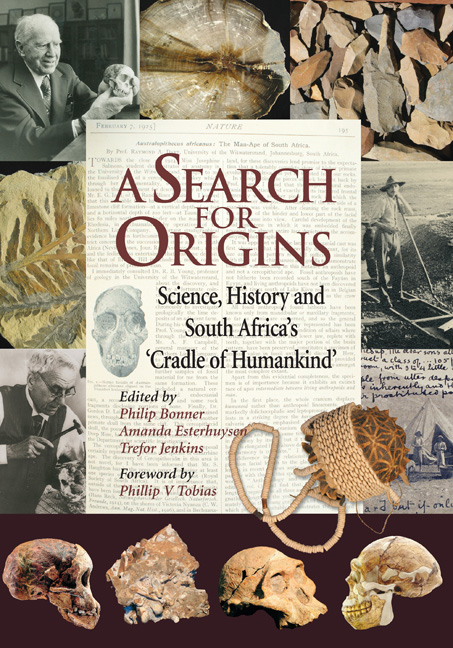Book contents
- Frontmatter
- Contents
- Map
- Foreword
- PART 1 Introduction: Africa is Seldom What It Seems
- PART 2 Introduction: Fossils and Genes: A New Anthropology of Evolution
- PART 3 Introduction: The Emerging Stone Age
- PART 4 Introduction: The Myth of the Vacant Land
- Chapter 9 The Early Iron Age at Broederstroom and Around the ‘Cradle of Humankind’
- Chapter 10 Tswana History in the Bankenveld
- Chapter 11 The Early Boer Republics: Changing Political Forces in the ‘Cradle of Humankind’, 1830s to 1890s
- PART 5 Introduction: The Racial Paradox: Sterkfontein, Smuts and Segregation
- Epilogue: Voice of Politics, Voice of Science: Politics and Science After 1945
- Notes, references and recommended reading
- Notes on contributors
- Acknowledgements
- Index
Chapter 9 - The Early Iron Age at Broederstroom and Around the ‘Cradle of Humankind’
from PART 4 - Introduction: The Myth of the Vacant Land
Published online by Cambridge University Press: 31 May 2019
- Frontmatter
- Contents
- Map
- Foreword
- PART 1 Introduction: Africa is Seldom What It Seems
- PART 2 Introduction: Fossils and Genes: A New Anthropology of Evolution
- PART 3 Introduction: The Emerging Stone Age
- PART 4 Introduction: The Myth of the Vacant Land
- Chapter 9 The Early Iron Age at Broederstroom and Around the ‘Cradle of Humankind’
- Chapter 10 Tswana History in the Bankenveld
- Chapter 11 The Early Boer Republics: Changing Political Forces in the ‘Cradle of Humankind’, 1830s to 1890s
- PART 5 Introduction: The Racial Paradox: Sterkfontein, Smuts and Segregation
- Epilogue: Voice of Politics, Voice of Science: Politics and Science After 1945
- Notes, references and recommended reading
- Notes on contributors
- Acknowledgements
- Index
Summary
About 1 800 years ago Bantu-speaking people brought a new way of life into southern Africa from further north. For the first time, people in this region began to cultivate such crops as sorghum, millets, ground beans and cowpeas, and they herded cattle as well as sheep and goats. Because of the demands of subsistence agriculture, settlements were intended to last a lifetime. As opposed to the temporary camps of pastoralists and hunter-gatherers, farmers lived in permanent settlements consisting of such features as houses, raised grain bins, underground storage pits and animal kraals. Because these early farming people also made their own iron tools, archaeologists call this block of time the Iron Age. For convenience and to mark widespread events, we divide it into three periods: the Early Iron Age (AD 200–900), the Middle Iron Age (AD 900–1300) and the Late Iron Age (AD 1300–1820).
The first two phases of the Iron Age remained totally unknown to South Africans, both black and white, until the early 1970s – an astonishingly late date in the country's history. The first recognition of their existence and the first identified Early Iron Age sites were at the farm ‘Silver Leaves’ near Tzaneen in the north-eastern Transvaal (now Limpopo province) and at Broederstroom, which lies in the Magaliesberg valley north of the ‘Cradle of Humankind’.
As mixed farmers, Early Iron Age people chose to live in broken country where there was sufficient water for domestic use and arable soil that could be cultivated with an iron hoe. With few exceptions, this concern for water and arable land continued until recent times. Generally, the dolomites in the Cradle are unsuitable for subsistence agriculture, and the Cradle is therefore devoid of Early Iron Age sites. The neighbouring Magaliesberg valley, on the other hand, was suitable.
Broederstroom (located at 24°45ʹE, 27°50ʹS) is an extensive Early Iron Age settlement in the Magaliesberg valley just north of the Cradle (Fig. 9.1). It was first excavated in the 1970s (Mason 1981, 1986) and then again a decade or so later (Huffman 1990, 1993). These excavations have yielded the remains of settled village life (storage pits, burnt daga houses/grain bins and enormous ceramic vessels), domestic animals (dung, bones and teeth), domestic crops (grindstones, phytoliths and storage facilities) and metallurgy (slag, blowpipes and forge bases), as well as a characteristic ceramic style.
- Type
- Chapter
- Information
- A Search for OriginsScience, History and South Africa's ‘Cradle of Humankind’, pp. 148 - 161Publisher: Wits University PressPrint publication year: 2007



